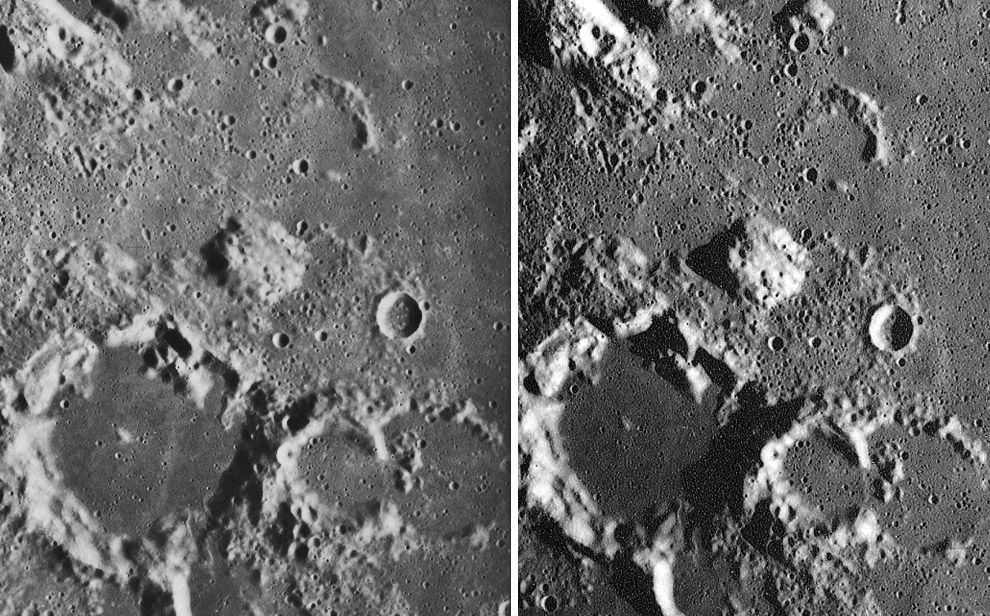|
|
| (8 intermediate revisions by the same user not shown) |
| Line 1: |
Line 1: |
| | __NOTOC__ | | __NOTOC__ |
| | =Mons of Mystery= | | =Mons of Mystery= |
| | + | <!-- Start of content --> |
| | + | <div class="post" id="post-350"> |
| | | | |
| − |
| + | <div class="storycontent"> |
| − | <div class="post" id="post-350">
| + | <p>[[File:Mons Maraldi-LPOD.jpg|Mons Maraldi-LPOD.jpg]]<br /> |
| − |
| |
| − | <div class="storycontent">
| |
| − | <p>[[File:Mons Maraldi-LPOD.jpg|Mons Maraldi-LPOD.jpg]]<br />
| |
| | <i>Image from [http://www.lpi.usra.edu/resources/apollo/catalog/metric/revolution/?AS17R14 Lunar and Planetary Institute]</i></p> | | <i>Image from [http://www.lpi.usra.edu/resources/apollo/catalog/metric/revolution/?AS17R14 Lunar and Planetary Institute]</i></p> |
| − | <p>Mount Maraldi is a little-studied round and flattish plateau on the western edge of Sinus Amoris near the crater Maraldi. Little seems to have been published about this odd feature so we will just have to look at it and decide what we see. These two Apollo 17 Metric camera excerpts show that the 16 km wide hill is isolated from other nearby hilly landforms and appears to be a stand-alone feature rather than an erosional remnant. The top is smoothish in the middle and surrounded by bumps and hills. According to the [http://www.lpi.usra.edu/resources/mapcatalog/LTO/lto43d2_1/ LTO] map, Mount Maraldi rises to a high point (6945 m) on its western edge and slopes down to 5800 m on its east base, for a maximum height of about 1150 m. Although it is not obvious from the images, the structure is not flat, but slopes to the east. A Clementine false color [http://pdsmaps.wr.usgs.gov/explorer-bin/mapmars4.cgi?WHEREFROM=COLOR&VERSION=INTERMEDIATE&DATA_SET_NAME=moon_clementine_ratio&PIXEL_TYPE=BIT8&SCALE=pixels/degree&PROJECTION=SINUSOIDAL&RESOLUTION=256&RESAMP_METHOD=NEAREST_NEIGHBOR&BANDS_SELECTED=%225,3,1%22&FORMAT=JPEG&LONBOX=4&LATBOX=4&GRIDLINE_FREQUENCY=none&STRETCH=AUTO&LAT=21&LON=35&LINE=1024&SAMP=968 image] reveals that the mountain does not stand out as having colors (and thus soil chemistry) significantly different than the surrounding non-mare material. Based on its shape I propose that Mount Maraldi is a volcanic dome similar to ones made of viscous lavas on Earth. It is not like classic lunar domes made of mare basalt, but is apparently a material that was not sampled during the Apollo explorations. If this is a dome of unusual composition it adds to the volcanic complexity of this region. [http://www.lpod.org/archive/LPOD-2005-05-27.htm Sinus Amoris] is full of classic domes and perhaps lava flow fronts, and nearby is the strange [http://www.lpod.org/archive/LPOD-2004-09-26.htm Gardner Megadome.] This will be a great area to explore on the ground later this century.</p> | + | <p>Mount Maraldi is a little-studied round and flattish plateau on the western edge of Sinus Amoris near the crater Maraldi. Little seems to have been published about this odd feature so we will just have to look at it and decide what we see. These two Apollo 17 Metric camera excerpts show that the 16 km wide hill is isolated from other nearby hilly landforms and appears to be a stand-alone feature rather than an erosional remnant. The top is smoothish in the middle and surrounded by bumps and hills. According to the [http://www.lpi.usra.edu/resources/mapcatalog/LTO/lto43d2_1/ LTO] map, Mount Maraldi rises to a high point (6945 m) on its western edge and slopes down to 5800 m on its east base, for a maximum height of about 1150 m. Although it is not obvious from the images, the structure is not flat, but slopes to the east. A Clementine false color [http://pdsmaps.wr.usgs.gov/explorer-bin/mapmars4.cgi?WHEREFROM=COLOR&VERSION=INTERMEDIATE&DATA_SET_NAME=moon_clementine_ratio&PIXEL_TYPE=BIT8&SCALE=pixels/degree&PROJECTION=SINUSOIDAL&RESOLUTION=256&RESAMP_METHOD=NEAREST_NEIGHBOR&BANDS_SELECTED=%225,3,1%22&FORMAT=JPEG&LONBOX=4&LATBOX=4&GRIDLINE_FREQUENCY=none&STRETCH=AUTO&LAT=21&LON=35&LINE=1024&SAMP=968 image] reveals that the mountain does not stand out as having colors (and thus soil chemistry) significantly different than the surrounding non-mare material. Based on its shape I propose that Mount Maraldi is a volcanic dome similar to ones made of viscous lavas on Earth. It is not like classic lunar domes made of mare basalt, but is apparently a material that was not sampled during the Apollo explorations. If this is a dome of unusual composition it adds to the volcanic complexity of this region. [[May_27,_2005|Sinus Amoris]] is full of classic domes and perhaps lava flow fronts, and nearby is the strange [[September_26,_2004|Gardner Megadome.]] This will be a great area to explore on the ground later this century.</p> |
| | <p>[mailto:tychocrater@yahoo.com Chuck Wood]</p> | | <p>[mailto:tychocrater@yahoo.com Chuck Wood]</p> |
| | <p><b>Technical Details:</b><br /> | | <p><b>Technical Details:</b><br /> |
| Line 15: |
Line 14: |
| | <p><b>Related Links:</b><br /> | | <p><b>Related Links:</b><br /> |
| | Rükl plate 25</p> | | Rükl plate 25</p> |
| − | <p><b> | + | <p><b>Yesterday's LPOD:</b> [[June 23, 2006|Rays & Pits]] </p> |
| − | <p align="center">
| + | <p><b>Tomorrow's LPOD:</b> [[June 25, 2006|On the Beach]] </p> |
| − | <i>You can support LPOD when you buy ANY book from Amazon thru [http://www.lpod.org/?page_id=102 LPOD!]</i></p>
| + | <!-- Removed reference to store page 2 --> |
| − | <p></b></p> | + | </div> |
| − | </div>
| + | <!-- End of content --> |
| − |
| + | {{wiki/ArticleFooter}} |
| − | | |
| − | ---- | |
| − | ===COMMENTS?===
| |
| − | Click on this icon [[image:PostIcon.jpg]] at the upper right to post a comment.
| |




